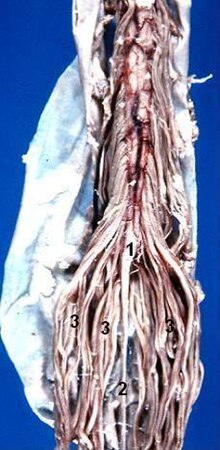Cauda equina
The cauda equina ( lat. Ponytail ) is an anatomical structure of the human being, which is located within the spine in a sac made of hard spinal cord skin ( dura mater spinalis ) and arachnoidea spinalis .
location
The cauda equina extends from the lower end of the spinal cord , the conus medullaris (in adults approximately at the level of the first lumbar vertebra ) to the sacrum . This is to horse tail like arrangement of nerve roots , which in the filled with cerebrospinal fluid and in the dural sac lying subarachnoid space extend until they reach the spine at different levels laterally through intervertebral foramina leave.
The cauda equina is normally located in the dural sac without tension, its position depends on the position (dorsal when lying down, ventrally when lying on the prone) and, in the ultrasound examination of newborns and infants, shows an oscillating movement pattern depending on breathing and liquor flow. If the nerve fibers tethered cord are attached caudally , the oscillation pattern is disrupted.
The course of the nerve fibers can be shown in detail in magnetic resonance imaging .
development
In the second month of development, the spinal cord fills the spinal canal over its full length. The nerve roots leave the spinal cord and the spine at roughly the same level. In the third month, the growth of the spinal cord slows down and lags behind the growth of the spine. As a result, there is a relative displacement of the spinal cord towards the skull (cranial), this is called ascensus. The consequence of this is that the nerve roots must run a path within the spinal canal corresponding to the extent of the ascensus before they leave the spine, since they retain their connection to the spinal cord and spine. In the sixth month of development, the end of the spinal cord extends to the sacral vertebrae, but at birth it is at the level of the third lumbar vertebra, and in adults at the level of the first to second lumbar vertebra.
Diseases
There are congenital changes that can hinder the aforementioned ascensus:
- MMC
- Post-operative scars
- Diastematomyelia
- Lipomas
- Obesity of the filum terminale
- Dermal sinus
Neurological diseases that are associated with damage to the cauda equina are referred to as the cauda equina syndrome .
Older domestic dogs of medium and large breeds are often affected by this disease (→ cauda equina syndrome in dogs ).
Individual evidence
- ↑ a b W. Schuster, D. Färber (Ed.): Children's radiology. Imaging diagnostics. Springer 1996, ISBN 3-540-60224-0 .
literature
- Pschyrembel: Clinical Dictionary
